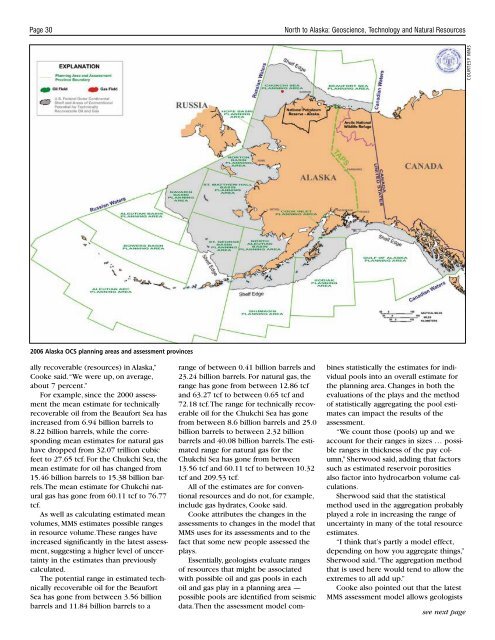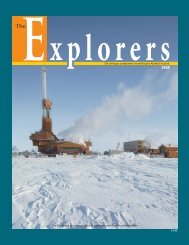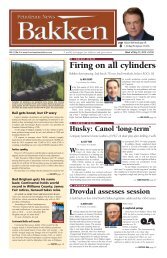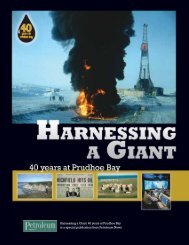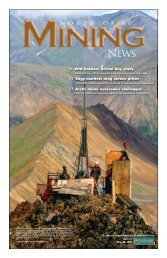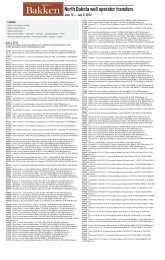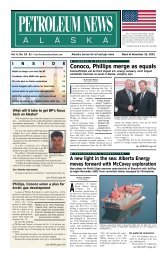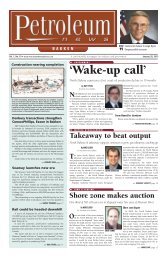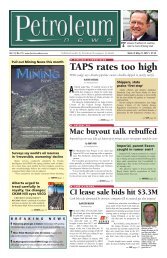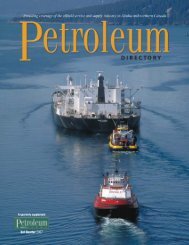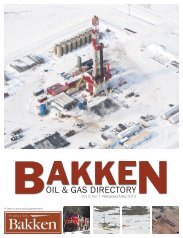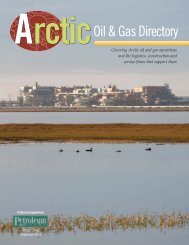North to Alaska - for Petroleum News
North to Alaska - for Petroleum News
North to Alaska - for Petroleum News
Create successful ePaper yourself
Turn your PDF publications into a flip-book with our unique Google optimized e-Paper software.
Page 30<br />
<strong>North</strong> <strong>to</strong> <strong>Alaska</strong>: Geoscience, Technology and Natural Resources<br />
COURTESY MMS<br />
2006 <strong>Alaska</strong> OCS planning areas and assessment provinces<br />
ally recoverable (resources) in <strong>Alaska</strong>,”<br />
Cooke said.“We were up, on average,<br />
about 7 percent.”<br />
For example, since the 2000 assessment<br />
the mean estimate <strong>for</strong> technically<br />
recoverable oil from the Beau<strong>for</strong>t Sea has<br />
increased from 6.94 billion barrels <strong>to</strong><br />
8.22 billion barrels, while the corresponding<br />
mean estimates <strong>for</strong> natural gas<br />
have dropped from 32.07 trillion cubic<br />
feet <strong>to</strong> 27.65 tcf. For the Chukchi Sea, the<br />
mean estimate <strong>for</strong> oil has changed from<br />
15.46 billion barrels <strong>to</strong> 15.38 billion barrels.The<br />
mean estimate <strong>for</strong> Chukchi natural<br />
gas has gone from 60.11 tcf <strong>to</strong> 76.77<br />
tcf.<br />
As well as calculating estimated mean<br />
volumes, MMS estimates possible ranges<br />
in resource volume.These ranges have<br />
increased significantly in the latest assessment,<br />
suggesting a higher level of uncertainty<br />
in the estimates than previously<br />
calculated.<br />
The potential range in estimated technically<br />
recoverable oil <strong>for</strong> the Beau<strong>for</strong>t<br />
Sea has gone from between 3.56 billion<br />
barrels and 11.84 billion barrels <strong>to</strong> a<br />
range of between 0.41 billion barrels and<br />
23.24 billion barrels. For natural gas, the<br />
range has gone from between 12.86 tcf<br />
and 63.27 tcf <strong>to</strong> between 0.65 tcf and<br />
72.18 tcf.The range <strong>for</strong> technically recoverable<br />
oil <strong>for</strong> the Chukchi Sea has gone<br />
from between 8.6 billion barrels and 25.0<br />
billion barrels <strong>to</strong> between 2.32 billion<br />
barrels and 40.08 billion barrels.The estimated<br />
range <strong>for</strong> natural gas <strong>for</strong> the<br />
Chukchi Sea has gone from between<br />
13.56 tcf and 60.11 tcf <strong>to</strong> between 10.32<br />
tcf and 209.53 tcf.<br />
All of the estimates are <strong>for</strong> conventional<br />
resources and do not, <strong>for</strong> example,<br />
include gas hydrates, Cooke said.<br />
Cooke attributes the changes in the<br />
assessments <strong>to</strong> changes in the model that<br />
MMS uses <strong>for</strong> its assessments and <strong>to</strong> the<br />
fact that some new people assessed the<br />
plays.<br />
Essentially, geologists evaluate ranges<br />
of resources that might be associated<br />
with possible oil and gas pools in each<br />
oil and gas play in a planning area —<br />
possible pools are identified from seismic<br />
data.Then the assessment model combines<br />
statistically the estimates <strong>for</strong> individual<br />
pools in<strong>to</strong> an overall estimate <strong>for</strong><br />
the planning area. Changes in both the<br />
evaluations of the plays and the method<br />
of statistically aggregating the pool estimates<br />
can impact the results of the<br />
assessment.<br />
“We count those (pools) up and we<br />
account <strong>for</strong> their ranges in sizes … possible<br />
ranges in thickness of the pay column,”<br />
Sherwood said, adding that fac<strong>to</strong>rs<br />
such as estimated reservoir porosities<br />
also fac<strong>to</strong>r in<strong>to</strong> hydrocarbon volume calculations.<br />
Sherwood said that the statistical<br />
method used in the aggregation probably<br />
played a role in increasing the range of<br />
uncertainty in many of the <strong>to</strong>tal resource<br />
estimates.<br />
“I think that’s partly a model effect,<br />
depending on how you aggregate things,”<br />
Sherwood said.“The aggregation method<br />
that is used here would tend <strong>to</strong> allow the<br />
extremes <strong>to</strong> all add up.”<br />
Cooke also pointed out that the latest<br />
MMS assessment model allows geologists<br />
see next page


